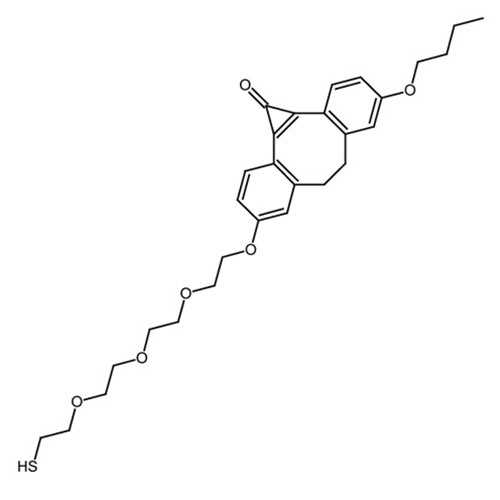Photo-DIBO-EG4-SH
Photo-DIBO-EG4-SH for strain-promoted cycloaddition applications.
Highlights:
- The only reagent on the market that permits photo-SPAAC ligation
- Especially engineered for the production of particles and surfaces with spatially resolved chemical functionality, of interest to many areas of science and technology including the fabrication of biochips, microfluidic devices, targeted drug delivery, MEMS and NEMS
- Photo-DIBO moiety does not react with organic or inorganic azides, thiols, water, and other endogenous nucleophiles, even at elevated temperatures
- Equipped with a thiol group for easy derivatization of gold and silver surface and nanoparticles, as well as for functionalization of substrate via Michael or thiol-ene addition
- Upon mild UVA irradiation releases azide-reactive derivative of popular DIBO SPAAC reagent
- Permits spatially-resolved conjugation using SPAAC, SPANC, SPANOC, IEDDA, and thiol-yne conjugations
- Long shelf life in the dark
Used as precursor in the preparation of water soluble 3nm gold nanoparticles, AuNP, that feature cyclopropenone-masked strained alkyne moieties capable of undergoing interfacial strain-promoted cycloaddition (i-SPAAC) with azides after exposure to UV-A light, providing for mild means of surface modification and templating. Suitable for use in conjunction with other metals.
The thiol functionality may be modified to promote attachment to other surfaces (e.g., into SO3H for attachment to cellulose, poly(hydroxyalkanoates), polyamines, etc., or into RS- by deprotonation, and the anionic formed used as ligand in metal complexes or organometallic compounds). Further, the cyclooctyne produced by light activation can be used in metathesis, Diels-Alder reactions, among others.
From the laboratory of Vladimir V. Popik, PhD, University of Georgia.
Photo-DIBO-EG4-SH for strain-promoted cycloaddition applications.
Highlights:
- The only reagent on the market that permits photo-SPAAC ligation
- Especially engineered for the production of particles and surfaces with spatially resolved chemical functionality, of interest to many areas of science and technology including the fabrication of biochips, microfluidic devices, targeted drug delivery, MEMS and NEMS
- Photo-DIBO moiety does not react with organic or inorganic azides, thiols, water, and other endogenous nucleophiles, even at elevated temperatures
- Equipped with a thiol group for easy derivatization of gold and silver surface and nanoparticles, as well as for functionalization of substrate via Michael or thiol-ene addition
- Upon mild UVA irradiation releases azide-reactive derivative of popular DIBO SPAAC reagent
- Permits spatially-resolved conjugation using SPAAC, SPANC, SPANOC, IEDDA, and thiol-yne conjugations
- Long shelf life in the dark
Used as precursor in the preparation of water soluble 3nm gold nanoparticles, AuNP, that feature cyclopropenone-masked strained alkyne moieties capable of undergoing interfacial strain-promoted cycloaddition (i-SPAAC) with azides after exposure to UV-A light, providing for mild means of surface modification and templating. Suitable for use in conjunction with other metals.
The thiol functionality may be modified to promote attachment to other surfaces (e.g., into SO3H for attachment to cellulose, poly(hydroxyalkanoates), polyamines, etc., or into RS- by deprotonation, and the anionic formed used as ligand in metal complexes or organometallic compounds). Further, the cyclooctyne produced by light activation can be used in metathesis, Diels-Alder reactions, among others.
From the laboratory of Vladimir V. Popik, PhD, University of Georgia.
| Product Type: | Small Molecule |
| Name: | Photo-DIBO-EG4-SH, Photo-DIBO-TEG-SH |
| Alternative Name(s): | 4-butoxy-9-(2-(2-(2-(2-mercaptoethoxy)ethoxy)ethoxy)ethoxy)-6,7-dihydro-1H-dibenzo[a,e]cyclopropa[c][8]annulen-1-one |
| Chemical Formula: | C29H36O6S |
| Molecular Weight: | 512.66 |
| Format: | yellow viscous oil |
| Purity: | >98% 1HNMR |
| Solubility: | CHCl3, DCM, THF, MeOH |
| Spectral Information: |
1HNMR (CDCl3, 400 MHz): 7.92-7.95 (d, J = 8.7 Hz, 2H), 6.88-6.92 (m, 4H), 4.20-4.23 (m, 2H), 4.03-4.06 (t, J = 6.5 Hz, 2H), 3.88-3.91 (m, 2H), 3.74-3.76 (m, 2H), 3.59-3.71 (m, 8H), 3.32-3.35 (d, J = 10.6, 2H), 2.61-2.64 (d, J = 10.7 Hz, 2H), 2.87-2.72 (m, 2H), 1.77-1.84 (m, 2H), 1.58- 1.63 (t, J = 7.4 Hz, 1H), 1.47-1.56 (m, 2H), 0.98-1.01 (t, 3H). 13C{1H} NMR (CDCl3, 101 MHz): 162.27, 161.76, 153.97, 147.98, 142.63, 142.19, 136.02, 135.91, 116.83, 116.55, 116.43, 116.37,112.55, 112.46, 73.07, 71.11, 70.90, 10.79, 70.43, 69.74, 68.20, 67.86, 37.39, 37.36, 31.34, 24.49, 19.40, 14.02. ESI HRMS: calcd. (M+H+): C29H37O6S 513.2305, found 513.2303. |
| Storage: | +10C; Protect from light |
| Shipped: | Ambient Temperature |
- Luo, W.; Gobbo, P.; Christopher McNitt, C.D.; Sutton, D.A.; Popik, V.V.; Workentin, M.S. “‘Shine & Click’ Photoinduced Interfacial Unmasking of Strained-Alkynes on Small Water Soluble Gold Nanoparticles”, Chemistry 2017, 25(5), 1052-1059, DOI: 10.1002/chem.201603398
- Orski, SV, Poloukhtine, AA, Arumugam, S, Mao, L, Popik, VV, Locklin, J: High density orthogonal surface immobilization via photoactivated copper-free click chemistry: (2010) J. of the Am. Chem. Soc. 132(32) 11024-11026
- Selvanathan Arumugam, Sara V. Orski, Ngalle Eric Mbua, Christopher McNitt, Geert-Jan Boons, Jason Locklin, and Vladimir V. Popik: Photo-click chemistry strategies for spatiotemporal control of metal-free ligation, labeling, and surface derivatization. Pure Appl. Chem., Vol. 85, No. 7, pp. 1499–1513, (2013)
- US Patents US8,258,347, US8,426,649 and US8,541,625
If you publish research with this product, please let us know so we can cite your paper.


